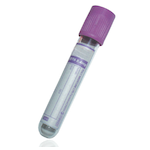Suitable Specimen Types
- Special Collection Procedures Apply
Specimen Transport
Send frozen.Sample Processing in Laboratory
A.S.A.P to lab on ice. Sample must be seperated and frozen within 15 min of venepuncture.Sample Preparation
Suggest collect blood into 2 special tubes for safety. Place on ice and transfer to laboratory. Discard visibly haemolysed specimens.At Laboratory: Separate plasma in refrigerated centrifuge and freeze plasma within 15 minutes of venepuncture.
Send frozen sample.
ollect blood in EDTA tubes (2-3) on ice, spin and freeze immediately. Send frozen
Turnaround Time
14 daysSample Stability
Freeze plasma at -20 oC within 15 min of venepunctureGut Hormones (glucagon, gastrin, VIP, somatastatin, pancreatic polypeptide)
General Information
A gut hormone screen is used for the diagnosis of a variety of endocrine tumours of the pancreas, ganglioneuromas, gastrinomas or G-cell hyperplasia. Analysis includes gastrin, VIP, somatostatin, pancreatic polypeptide, and glucagon.
The gastrin test is usually requested to help detect high levels of gastrin and stomach acid. It is used to help diagnose gastrin-producing tumours called gastrinomas, Zollinger-Ellison (ZE) syndrome, and hyperplasia of G-cells, specialised cells in the stomach that produce gastrin. It may be measured to screen for the presence of multiple endocrine neoplasia type I (MEN) It may be used if a person has abdominal pain, diarrhoea, and recurrent peptic ulcers. A gastrin test may also be requested to look for recurrence of disease following surgical removal of a gastrinoma.
Vasoactive intestinal peptide (VIP) measurement is required for diagnosis of pancreatic tumour or a ganglioneuroma which secretes VIP. Administration of VIP to animals causes hyperglycaemia, inhibition of gastric acid, secretion of pancreatic bicarbonate and of small intestinal juice, and a lowering of systemic blood pressure with skin flush. These features are seen in patients with a tumour of this type which is secreting VIP.
Glucagon is measured for preoperative diagnosis of a glucagon-producing tumour of the pancreas in patients with diabetes and a characteristic skin rash (necrolytic migratory erythema).
Pancreatic polypeptide (PP) production is most commonly associated with tumours producing vasoactive intestinal polypeptide and with carcinoid syndrome and, less commonly, with insulinomas and gastrinomas.
When secreted by endocrine tumours, somatostatin appears to produce symptoms similar to those seen on pharmacological administration, i.e. steatorrhoea, diabetes mellitus and gall stones.
Patient Preparation
Patient should be fasted overnight.
Patients should have stopped taking PPIs for 14 days and Hydrogen recptor antagonist for 72 hrs prior to blood sample being taken.
Notes
Analysis includes gastrin, VIP, somatostatin, pancreatic polypeptide, and glucagon. Neurotensin was previously offered as part of the gut hormone tumour service. This has since been withdrawn because it has been found to offer little diagnostic value over chromogranin A and B in neuroendocrine tumours. Neurotensin can however be requested separately in the diagnosis of fibrolamellar hepatic carcinoma. A new gut hormone called cocaine-and amphetamine related transcript (CART) will be available by the end of 2008 as part of the gut hormone profile.
To aid with gastrin analysis, please record on the SAS request form the patient's serum calcium and urea levels, a list of all drugs currently administered, details of any gastric surgery the patient has undergone, basal and stimulated acid output.
Contact Duty Biochemist (2506) prior to sample collection. This sample MUST BE collected on ice. If you require ice, please contact specimen reception 42252.
Reference Range
Provided by Reference Laboratory
Specifications
- EQA Status: Gastrin only
